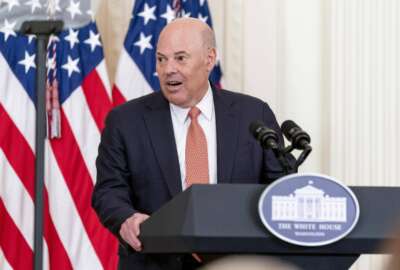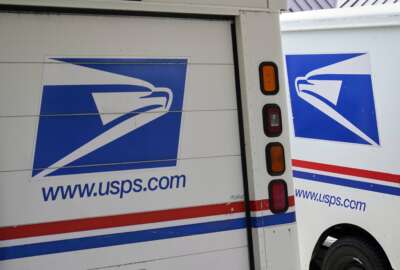USPS outlines plan to ‘aggressively’ reduce carbon footprint by 2030
The Postal Service is planning to significantly reduce its carbon footprint by the end of the decade, as it rolls out a majority-electric fleet and consolidates...
The Postal Service is planning to significantly reduce its carbon footprint by the end of the decade, as it rolls out a majority-electric fleet and consolidates facilities.
USPS, by 2030, expects to cut carbon emissions from fuel and electricity by 40% and reduce emissions from contracted services by 20%.
Postmaster General Louis DeJoy told reporters on Tuesday these plans to “aggressively reduce our greenhouse gas emissions,” will give USPS an advantage over its competitors, as it looks to grow its package business.
“Through our efforts, the Postal Service will be the most sustainable way to mail and ship,” DeJoy said.
The agency is looking to meet its sustainability goals through projects that are already underway to cut $5 billion in costs in the coming years and grow revenue by the same amount.
“This plan is just not about cutting costs. It’s about bringing us into the modern, competitive world of package delivery,” DeJoy said.
Among those cost-cutting efforts, the agency is consolidating its massive network of facilities across the country, to eliminate thousands of unnecessary trips each day to deliver mail and packages.
“For every dollar we spend to do our work, we burn carbon. Therefore, for every dollar we don’t spend to do our work, we don’t burn carbon,” DeJoy said.
USPS expects to meet its sustainability targets in part by rolling out a majority-electric vehicle fleet. The agency will receive its first round of electric vehicles later this year.
DeJoy said USPS will receive about 10,000 commercially available electric vehicles from Ford this year. The agency, he added, will receive the first 100 custom-built, electric next-generation delivery vehicles (NGDVs) from Oshkosh Defense by the “tail-end of this year.”
USPS will receive another 5,000 electric NGDVs in 2025. The rest will arrive in 2026 and 2027.
In total, the agency expects to purchase more than 100,000 electric and gas-powered delivery vehicles through 2028. The agency expects electric vehicles will make up at least 62% of its new fleet.
USPS owns about a third of all federal vehicles and ranks second only to the Defense Department in terms of agencies with the largest vehicle inventory.
USPS Chief Logistics Officer and Executive Vice President Kelly Abney said agency operations account for about 1.9 billion miles driven each year.
”This effort to replace our aging fleet will have an immediate impact on greenhouse gas emissions for every vehicle we put into service,” Abney said.
DeJoy said USPS is on track to be a “leader in EV deployment” and is setting a high bar for overall carbon reduction.
“We are reducing miles. [Reducing] miles reduces carbon,” he said.
USPS is also shifting more mail and package volume away from air transportation contractors, and instead delivering it through its ground transportation network.
USPS has repeatedly said it will look for additional opportunities to buy more electric vehicles. DeJoy said the USPS’ electric vehicle commitment “most likely will grow significantly as we move forward.”
“I think the operating efficiencies of using electric vehicles will become more and more and more evident,” he said.
USPS last month unveiled its first set of electric vehicle charging stations at a Sorting and Delivery Center (S&DC) in Atlanta.
S&DCs are large facilities that consolidate the operations of letter carriers and mail handlers under one roof. USPS plans to have 100 of them up and running by the end of this year, and over 400 S&DCs in the next three years.
In addition to consolidating its footprint, DeJoy has also stressed that S&DCs are critical for the success of a mostly electric next-generation vehicle fleet because they have the space and infrastructure necessary to charge electric vehicles.
“As our S&DCs roll out, we can accommodate the electric vehicle infrastructure in a more competitive, cost-effective way,” DeJoy said.
DeJoy said S&DCs and new regional processing centers will have smart lighting, energy-efficient heating and air-conditioning, and renewable energy sources.
As part of this consolidation effort, however, DeJoy said USPS employees in some cases will have to drive about five to 15 miles further to report to work.
“People may have to move a few miles to report to work. Our employees are committed to the success of the Postal Service. I am sure they will do that,” DeJoy said.
Jennifer Beiro-Réveillé, USPS senior director of environmental affairs and corporate sustainability, said the agency is on track to meet the Biden administration’s green-government goals.
“Not only are we working to align with the Biden administration’s targets for reduced carbon emissions, we are exceeding so many of the targets of our peers,” Beiro-Réveille said.
The White House said in December 2022 that current USPS fleet plans “will exceed President Biden’s requirement for each agency to electrify its federal fleet.”
USPS is spending about $10 billion on its new fleet, but Congress gave the agency $3 billion in the Inflation Reduction Act to buy more electric vehicles and charging stations than it could otherwise afford.
“The funding Congress and the administration chose to commit to our fleet electrification helped us go further down a road we couldn’t possibly otherwise have traveled so far — and so soon — on our own,” said Peter Pastre, USPS vice president of government relations and public policy.
The agency is also looking to increase the recycled content of its packaging. It also plans to divert 75% of its waste from landfills, with a focus on recycling more paper, cardboard, and shrink-wrap packaging.
Copyright © 2025 Federal News Network. All rights reserved. This website is not intended for users located within the European Economic Area.
Jory Heckman is a reporter at Federal News Network covering U.S. Postal Service, IRS, big data and technology issues.
Follow @jheckmanWFED






